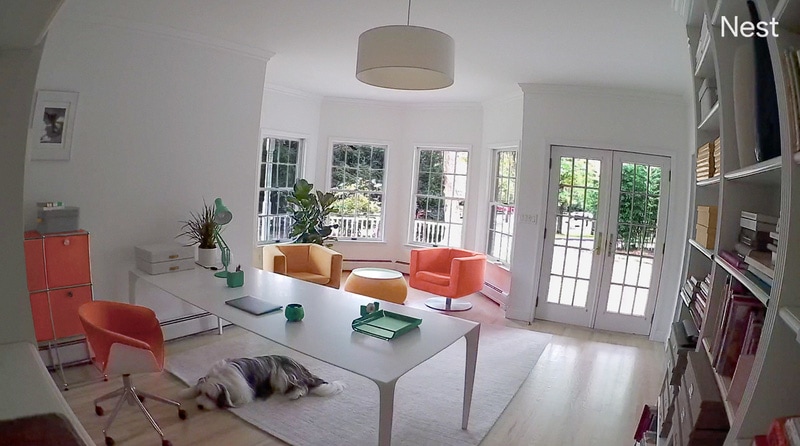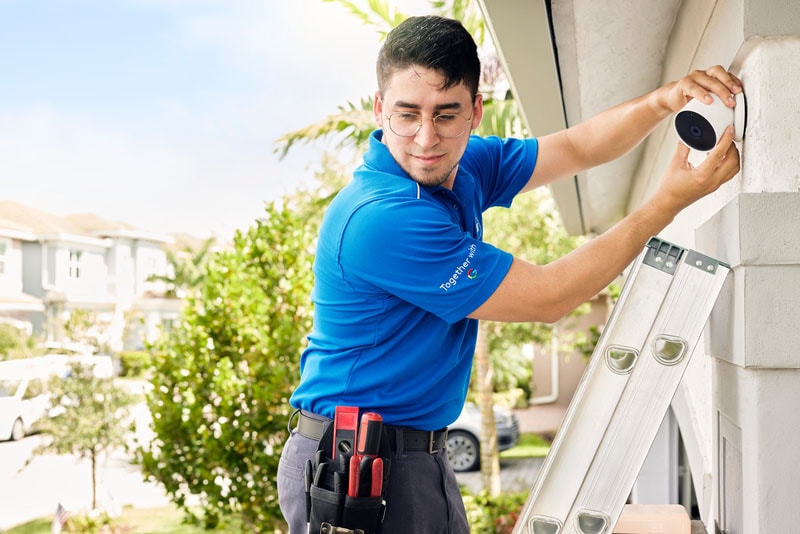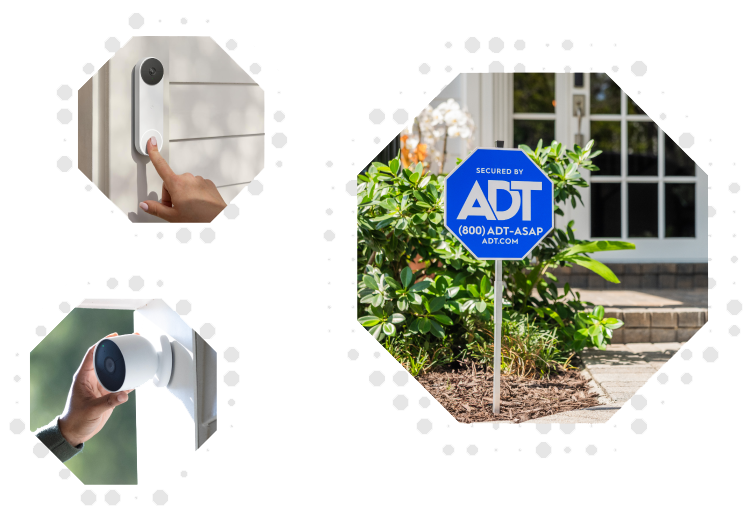5 Home Security Vulnerabilities to Check When Moving Into a New House

5 Home Security Vulnerabilities to Check When Moving Into a New House
Key Takeaways
Rekey all locks to eliminate access from previous owners or contractors.
Secure doors, windows, and garages to close easy entry points.
Improve outdoor visibility with lighting and cameras to deter unwanted activity.
Check for and activate a security system or consider installing a new one.
Update Wi-Fi settings and smart devices to prevent digital vulnerabilities.
Moving into a new home? Don't overlook these security gaps that could put your safety at risk-and learn how to fix them quickly and confidently.
Moving into a new home is a major milestone—and while unpacking boxes and arranging furniture might be top of mind, there’s another priority that deserves immediate attention: your home’s security.
The reality is, even a freshly built or recently sold home can have hidden vulnerabilities. From outdated locks to overlooked entry points, many new homeowners unintentionally inherit risks they haven't thought to check.
Whether your home is brand new or new to you, the first few days are the perfect time to identify and address potential security gaps. In this article, we'll walk through five of the most common vulnerabilities-and what you can do to help protect your new space from the start.
Old Locks, Unknown Keys
One of the easiest things to overlook when moving into a new house is who else might still have access. Previous homeowners, real estate agents, contractors, cleaners, or even neighbors may have kept a spare key-and unless you've changed the locks, they could still use it.
Why It Matters:
Unlike visible damage or missing items, unauthorized access leaves no trace until something goes wrong. Even if the locks "seem fine," you can't be sure how many copies are out there or who's holding them.
What You Can Do:
- Rekey the locks as soon as you take possession of the home. It’s a fast, affordable step that makes old keys useless.
- Consider replacing hardware entirely if the locks are worn, damaged, or outdated.
- Add deadbolts to doors that only have knob locks—especially on back doors or garage entries.
Smart Alternatives:
If you're looking for more flexibility, smart locks can give you remote access, temporary codes for guests or service providers, and real-time activity alerts. Some models even auto-lock if you forget to secure the door behind you.
Reestablishing control over who has access is one of the most important first steps to creating a secure home environment.
Unsecured Entry Points (Doors, Windows, Garage)
Even with new locks in place, your home may still have vulnerable entry points that are easy to overlook—especially in the early days after moving in. Windows left unlatched, weak door frames, or an unreinforced garage can create easy access for intruders.
Why It Matters:
Most break-ins happen through first-floor entry points-and it doesn't take much for someone to exploit a window left cracked open or a garage that doesn't fully latch. These areas are often overlooked during the hustle of moving in, but they're among the most important to secure.
What You Can Do:
- Inspect every exterior door for sturdy hinges, tight-fitting frames, and a deadbolt that fully extends into the strike plate.
- Check windows—especially ground-level and basement ones—for working locks and full closure.
- Don’t forget the garage: Make sure the door closes completely, the remote is secure, and that the interior door to the house has a solid lock.
Options to Consider:
- Install door and window sensors that alert you when they’re opened.
- Use reinforcement plates or longer screws in door frames to strengthen entry resistance.
- Consider security bars or locks for sliding doors and basement windows.
A quick walkthrough of your home's perimeter-day and night-can reveal surprising blind spots. Securing these areas early not only deters intrusion, but also helps you feel confident and in control in your new space.
Lack of Visibility Around Your Home’s Exterior
If you can't see what's happening around your home's exterior, you're less likely to catch suspicious behavior-or even know when deliveries arrive or visitors approach. Poor lighting, obstructed sightlines, and the absence of cameras all limit your awareness and increase the chance of unnoticed activity.
Why It Matters:
Many intrusions begin with simple observation. If someone can approach your property undetected, especially in low-light areas like side yards, back doors, or driveways, it becomes easier for them to test boundaries without being noticed.
What You Can Do:
- Walk your property at night and note areas that feel too dark or hidden from view.
- Trim landscaping that blocks windows, doorways, or line-of-sight from the street.
- Add motion-activated lighting around key zones—such as front steps, garages, and side entrances.
Add Visibility with Cameras:
- Install exterior cameras near entry points to monitor activity and act as a visible deterrent.
- Choose models that offer night vision, mobile alerts, and live viewing for greater coverage when you’re away.
- For homes with porches or high delivery volume, doorbell cameras can help capture who’s coming and going in real time.
Being able to see what’s happening outside your home—especially at night—adds not just awareness, but confidence.
Want better nighttime awareness and deterrence? Explore ADT’s outdoor camera options with night vision to help you see more around your home—day or night.


No Active Security System in Place
Many new homes are sold without a functioning security system-or have legacy equipment that hasn't been updated, activated, or properly maintained. That means you could be living in your new home for weeks or months without any active protection in place.
Why It Matters:
Even if your neighborhood feels safe, your new home is unfamiliar territory. You may not yet know which doors or windows are most vulnerable, how often solicitors or service workers approach your home, or what patterns (if any) exist around local crime or break-ins.
What You Can Do:
- Check for existing security hardware: Look for sensors, cameras, motion detectors, or wall-mounted keypads left behind by previous owners.
- Assess what’s usable: Some systems can be reactivated or updated with minimal effort—others may need to be replaced or supplemented.
- Determine your coverage needs: Think about the areas you want to monitor (entryways, bedrooms, garage, etc.) and whether you want notifications, recording, or professional monitoring support.
Options to Consider:
- DIY setups allow you to build a system over time.
- Professionally monitored systems provide 24/7 support and dispatch services in the event of an alarm—offering peace of mind, especially when you’re away.
Starting with even modest protection can go a long way toward making your new home feel safer and more secure.


Unsecured Wi-Fi and Smart Home Devices
Smart home tech can add convenience and security-but only when it's properly set up. Many new homeowners move in and immediately connect to the existing Wi-Fi network or begin using smart devices (like locks, cameras, or thermostats) without updating login credentials or reviewing device settings.
Why It Matters:
If your router or connected devices still use default usernames, passwords, or outdated firmware, they could be vulnerable to unauthorized access.
What You Can Do:
- Change the Wi-Fi network name and password as soon as possible—even if the router was provided by the previous owner or builder.
- Create a separate guest network for smart devices to reduce exposure on your main connection.
- Reset and reconfigure any smart home devices left behind, including garage openers, cameras, locks, or thermostats.
Boost Digital Security:
- Update firmware on all connected devices to ensure you have the latest security patches.
- Enable two-factor authentication (2FA) on smart home apps when available.
- Delete old app users or access codes from any inherited equipment.
As homes become more connected, securing your digital entry points is just as important as securing your physical ones. Taking a few minutes to lock down your network and devices can help prevent digital vulnerabilities from becoming real-world risks.
If you’ve just moved in and haven’t set up internet yet—or live in an area with unreliable broadband—ADT+ now offers a cellular-only protection option. It lets you help protect your devices, receive alerts, and monitor activity even before your Wi‑Fi is up and running.
Additional Tips for Securing Your New Home
Here are a few more smart, move-in–friendly tips that can help close common security gaps before they become problems:
Reset Garage Door Openers and Keypads
Many homeowners forget that garage door remotes and keypads often retain codes from previous owners. Reset the keypad, erase old remotes from the system memory, and pair only your new devices.
Replace or Remove Hidden Spare Keys
It's common for sellers to leave a key "hidden" under a doormat or flowerpot for agents or contractors. If you're not sure where those might be-or if they've been passed around-collect or eliminate all outdoor hiding spots.
Inspect Fencing and Gates for Access Points
Walk your yard and check for loose boards, sagging gates, or sections that could be easily bypassed. Repair weak points and consider adding latches or locks to prevent unwanted access.
Test All Doorbells, Intercoms, and Entry Alerts
Doorbell systems and intercoms may not have been used in months. Make sure they're functioning properly, connected to power, and not linked to a previous owner's account or app.
Each of these small upgrades can contribute to a safer, more secure home—and give you peace of mind as you settle into your new space.
FAQs
What’s the first thing I should do for home security after moving in?
Start by changing or rekeying all exterior door locks. You never know how many spare keys are still in circulation from previous owners, contractors, or real estate professionals. Once that's done, walk through the home to check windows, garage access points, and lighting coverage.
How do I know if the previous owners still have access to smart devices?
Unless the devices were factory-reset and set up under your account, there's a chance someone else may still have remote access. Always reset smart locks, garage controllers, doorbells, and thermostats-and check for any lingering app users or access codes.
Is it safe to use the existing security system that came with the house?
Possibly. Many systems can be reactivated, updated, or repurposed. The key is to ensure all devices are functioning, unlinked from the previous owner's account, and set up under your control. If in doubt, a technician or support team may be able to assist with a reset or upgrade.
Should I prioritize cameras, sensors, or locks first?
If budget or timing limits your options, start with the basics: secure locks on all exterior doors, followed by door/window sensors and a doorbell or porch camera. These give you the most immediate control and visibility during the early move-in period.
Final Thoughts
Moving into a new home is the perfect opportunity to take control of your security from day one. While unpacking and decorating may be your top priorities, addressing a few key vulnerabilities early on can make a meaningful difference in how safe and settled you feel.
From replacing old locks to securing Wi-Fi-connected devices, each step you take adds to your peace of mind. And the good news? Most of these fixes are simple, affordable, and easy to tackle in your first week.
A secure home doesn't happen by accident-it's built through awareness, preparation, and smart decisions made early. By checking these vulnerabilities now, you're not just helping to protect your new space-you're creating a safer, more confident start in your new chapter.
Ready to take control of your new home’s security?
From replacing locks to setting up mobile alerts, every step you take builds a stronger foundation for peace of mind. Explore ADT’s smart home security solutions to help protect what matters most—starting day one.




